Multi-Approach Study Applied to Restoration Monitoring of a 16th Century Wooden Paste Sculpture
Abstract
1. Introduction
2. Materials and Methods
2.1. Study by Traditional Techniques (OM, FTIR and SEM-EDX)
2.2. Study by Laser Induced Fluorescence
2.3. Study by XRF-XRD
3. Results and Discussion
3.1. Study by Traditional Techniques (OM, FTIR and SEM-EDX)
3.2. Study by Laser Induced Fluorescence
3.3. Study by XRF-XRD and Comparison with Traditional Techniques
4. Conclusions
Author Contributions
Funding
Acknowledgments
Conflicts of Interest
References
- Borgia, I.; Fantoni, R.; Flamini, C.; Di Palma, T.M.; Guidoni, A.G.; Mele, A. Luminescence from pigments and resins for oil paintings induced by laser excitation. Appl. Surf. Sci. 1998, 127–129, 95–100. [Google Scholar] [CrossRef]
- Nevin, A.; Cather, S.; Anglos, D.; Fotakis, C. Analysis of protein-based binding media found in paintings using laser induced fluorescence spectroscopy. Anal. Chim. Acta 2006, 573–574, 341–346. [Google Scholar] [CrossRef] [PubMed]
- Nevin, A.; Anglos, D. Assisted Interpretation of Laser-Induced Fluorescence Spectra of Egg-Based Binding Media Using Total Emission Fluorescence Spectroscopy. Laser Chem. 2006, 2006, 1–5. [Google Scholar] [CrossRef][Green Version]
- Anglos, D.; Solomidou, M.; Zergioti, I.; Zafiropulos, V.; Papazoglou, T.G.; Fotakis, C. Laser-Induced Fluorescence in Artwork Diagnostics: An Application in Pigment Analysis. Appl. Spectrosc. 1996, 50, 1331–1334. [Google Scholar] [CrossRef]
- Marinelli, M.; Pasqualucci, A.; Romani, M.; Verona-Rinati, G. Time resolved laser induced fluorescence for characterization of binders in contemporary artworks. J. Cult. Herit. 2017, 23, 98–105. [Google Scholar] [CrossRef]
- Fiorani, L.; Caneve, L.; Colao, F.; Fantoni, R.; Ortiz, P.; Gómez, M.A.; Vázquez, M.A.; Gomez, M.A.; Vazquez, M.A.; Gómez, M.A.; et al. Real-Time Diagnosis of Historical Artworks by Laser-Induced Fluorescence. Adv. Mater. Res. 2010, 133–134, 253–258. [Google Scholar] [CrossRef]
- Comelli, D.; Nevin, A.; Valentini, G.; Osticioli, I.; Castellucci, E.M.; Toniolo, L.; Gulotta, D.; Cubeddu, R. Insights into Masolino’s wall paintings in Castiglione Olona: Advanced reflectance and fluorescence imaging analysis. J. Cult. Herit. 2011, 12, 11–18. [Google Scholar] [CrossRef]
- Comelli, D.; D’Andrea, C.; Valentini, G.; Cubeddu, R.; Colombo, C.; Toniolo, L. Fluorescence lifetime imaging and spectroscopy as tools for nondestructive analysis of works of art. Appl. Opt. 2004, 43, 2175–2183. [Google Scholar] [CrossRef]
- Colao, F.; Fantoni, R.; Fiorani, L.; Palucci, A. Portable fluorescence device for space scanning of surfaces, especially for cultural heritage applications “Dispositivo portatile a fluorescenza per la scansione spaziale di superfici, in particolare nell’ambito dei beni culturali”. RM2007A000278, 2007. [Google Scholar]
- Domingo, C.; Silva, D.; García-Ramos, J.V.; Castillejo, M.; Martín, M.; Oujja, M.; Torres, R.; Sánchez-Cortés, S. Spectroscopic Analysis of Pigments and Binding Media of Polychromes by the Combination of Optical Laser-Based and Vibrational Techniques. Appl. Spectrosc. 2001, 55, 992–998. [Google Scholar]
- Oujja, M.; Vázquez-Calvo, C.; Sanz, M.; de Buergo, M.Á.; Fort, R.; Castillejo, M. Laser-induced fluorescence and FT-Raman spectroscopy for characterizing patinas on stone substrates. Anal. Bioanal. Chem. 2012, 402, 1433–1441. [Google Scholar] [CrossRef]
- Syvilay, D.; Bai, X.S.; Wilkie-Chancellier, N.; Texier, A.; Martinez, L.; Serfaty, S.; Detalle, V. Laser-induced emission, fluorescence and Raman hybrid setup: A versatile instrument to analyze materials from cultural heritage. Spectrochim. Acta Part B At. Spectrosc. 2018, 140, 44–53. [Google Scholar] [CrossRef]
- Eveno, M.; Moignard, B.; Castaing, J. Portable apparatus for in situ x-ray diffraction and fluorescence analyses of artworks. Microsc. Microanal. 2011, 17, 667–673. [Google Scholar] [CrossRef] [PubMed]
- Gianoncelli, A.; Castaing, J.; Ortega, L.; Dooryhée, E.; Salomon, J.; Walter, P.; Hodeau, J.-L.; Bordet, P. A portable instrument for in situ determination of the chemical and phase compositions of cultural heritage objects. X-ray Spectrom. 2008, 37, 418–423. [Google Scholar] [CrossRef]
- Ferrett, M. X-ray Fluorescence Applications for the Study and Conservation of Cultural Heritage. In Radiation in Art and Archeometry; Creagh, D.C., Bradley, D.A., Eds.; Elsevier: Amsterdam, The Netherlands, 2000; pp. 285–296. [Google Scholar] [CrossRef]
- Artioli, G. Science for the cultural heritage: The contribution of X-ray diffraction. Rend. Lincei 2013, 24, 55–62. [Google Scholar] [CrossRef]
- Lutterotti, L.; Dell’Amore, F.; Angelucci, D.E.; Carrer, F.; Gialanella, S. Combined X-ray diffraction and fluorescence analysis in the cultural heritage field. Microchem. J. 2016, 126, 423–430. [Google Scholar] [CrossRef]
- Mendoza Cuevas, A.; Bernardini, F.; Gianoncelli, A.; Tuniz, C. Energy dispersive X-ray diffraction and fluorescence portable system for cultural heritage applications. X-ray Spectrom. 2015, 44, 105–115. [Google Scholar] [CrossRef]
- Uda, M. In situ characterization of ancient plaster and pigments on tomb walls in Egypt using energy dispersive X-ray diffraction and fluorescence. Nucl. Instrum. Methods Phys. Res. Sect. B Beam Interact. Mater. Atoms 2004, 226, 75–82. [Google Scholar] [CrossRef]
- Van De Voorde, L.; Van Pevenage, J.; De Langhe, K.; De Wolf, R.; Vekemans, B.; Vincze, L.; Vandenabeele, P.; Martens, M.P.J. Non-destructive in situ study of “mad Meg” by Pieter Bruegel the Elder using mobile X-ray fluorescence, X-ray diffraction and Raman spectrometers. Spectrochim. Acta Part B At. Spectrosc. 2014, 97, 1–6. [Google Scholar] [CrossRef]
- Gómez-Morón, M.A.; Ortiz, P.; Martín-Ramírez, J.M.; Ortiz, R.; Castaing, J. A new insight into the vaults of the kings in the Alhambra (Granada, Spain) by combination of portable XRD and XRF. Microchem. J. 2016, 125, 260–265. [Google Scholar] [CrossRef]
- Chiari, G.; Sarrazin, P.; Heginbotham, A. Non-conventional applications of a noninvasive portable X-ray diffraction/fluorescence instrument. Appl. Phys. A Mater. Sci. Process. 2016, 122, 990. [Google Scholar] [CrossRef]
- Pérez del Campo, L.; Montero Moreno, A.; González González, M.; Ojeda Calvo, R.; Villanueva Romero, E.; Rubio Faure, C.; Martín García, L.; Gómez-Morón, A.; Fernández Ruiz, E. Proyecto de conservación Cristo de la Expiración Marcos Cabrera y Juan Díaz, 1575; Hermandad del Museo: Sevilla, Spain, 2012. [Google Scholar]
- Rubio, C.; Pérez del Campo, L.; Montero Moreno, A.; González González, M. Memoria Final de Intervención Cristo de la Expiración. Marcos Cabrera 1575; Hermandad del Museo: Sevilla, Spain, 2013. [Google Scholar]
- AENOR UNE-EN 16085. Conservation of Cultural Property. Methodology for Sampling from Materials of Cultural Property. General Rules. 2014. Available online: https://www.une.org/encuentra-tu-norma/busca-tu-norma/norma?c=N0053258 (accessed on 17 August 2020).
- Lognoli, D.; Cecchi, G.; Mochi, I.; Pantani, L.; Raimondi, V.; Chiari, R.; Johansson, T.; Weibring, P.; Edner, H.; Svanberg, S. Fluorescence lidar imaging of the cathedral and baptistery of Parma. Appl. Phys. B Lasers Opt. 2003, 76, 457–465. [Google Scholar] [CrossRef]
- Colao, F.; Caneve, L.; Fantoni, R.; Fiorani, L.; Palucci, A.; Fantoni, R.; Fiorani, L. Scanning hyperspectral lidar fluorosensor for fresco diagnostics in laboratory and field campaigns. In Proceedings of the International Conference LACONA 7; CRC Press: Boca Raton, FL, USA, 2008; pp. 149–155. [Google Scholar]
- Colao, F.; Fantoni, R.; Fiorani, L.; Palucci, A. Application of a scanning hyperspectral lidar fluorosensor to fresco diagnostics during the CULTURE 2000 campaign in Bucovina. Rev. Monum. Istor./Rev. Hist. Monum. 2006, LXXV, 53–61. [Google Scholar]
- Colao, F.; Caneve, L.; Fiorani, L.; Palucci, A.; Fantoni, R.; Ortiz, M.P.; Gómez, M.A.; Vázquez, M.A. Report on Lif Measurements in Seville. Part 1: Virgen Del Buen Aire Chapel. In Rapporti Tecnici della ENEA; ENEA: Roma, Italy, 2012; Volume 11, pp. 1–30. [Google Scholar]
- Colao, F.; Caneve, L.; Fiorani, L.; Palucci, A.; Fantoni, R.; Ortiz, M.P.; Gómez, M.A.; Vázquez, M.A. Report on LIF measurements in Seville—Part 2: Santa Ana Church. In Rapporti Tecnici della ENEA; ENEA: Roma, Italy, 2012; Volume 8, pp. 1–29. [Google Scholar]
- Caneve, L.; Colao, F.; Fantoni, R.; Fiorani, L.; Fornarini, L. Compact scanning hyperspectral lidar fluorosensor for the discrimination of varnishes and consolidants. In Proceedings of the International Workshop-SMW08 “In Situ Monitoring of Monumental Surfaces”; CNR: Florence, Italy, 2008. [Google Scholar]
- Fornarini, L.; Caneve, L.; Colao, F.; Fantoni, R.; Fiorani, L. Laser induced fluorescence analysis of acrylic resins used in conservation of cultural heritage. In Proceedings of the OSAV’2008, 2nd Int. Topical Meeting on Optical Sensing and Artificial Vision, St. Petersburg, Russia, 12–15 May 2008; pp. 57–63. [Google Scholar]
- Access, Research and Technology for the Conservation of the European Cultural Heritage | EU-ARTECH Project | FP6 | CORDIS | European Commission. Available online: https://cordis.europa.eu/project/id/506171/es (accessed on 29 April 2020).
- Cultural heritage Advanced Research Infrastructures: Synergy for a Multidisciplinary Approach to Conservation/Restoration | CHARISMA Project | FP7 | CORDIS | European Commission. Available online: https://cordis.europa.eu/project/id/228330 (accessed on 29 April 2020).
- Gómez-Morón, M.A. Estudio estratigráfico de capas pictóricas del Cristo de la Expiración; Hermandad del Museo: Sevilla, Spain, 2012. [Google Scholar]
- Kovala-Demertzi, D.; Papathanasis, L.; Mazzeo, R.; Demertzis, M.A.; Varella, E.A.; Prati, S. Pigment identification in a Greek icon by optical microscopy and infrared microspectroscopy. J. Cult. Herit. 2012, 13, 107–113. [Google Scholar] [CrossRef]
- KIRBY, J.; SPRING, M.; HIGGITT, C. The Technology of Red Lake Pigment Manufacture: Study of the Dyestuff Substrate. Natl. Gall. Tech. Bull. 2005, 26, 71–87. [Google Scholar]
- VV.AA. Artists’ Pigments. In A Handbook of Their History and Characteristics; Feller, R.L., Ed.; Archetype Publications: London, UK, 2012; Volume 1, ISBN 978-1-904982-74-6. [Google Scholar]
- VV.AA. Artists’ Pigments. In A Handbook of Their History and Characteristics; Fitzhugh, E.W., Ed.; Archetype Publications: London, UK, 2012; Volume 3, ISBN 978-1-904982-75-3. [Google Scholar]
- Acquaviva, S.; D’Anna, E.; De Giorgi, M.L.; Della Patria, A.; Pezzati, L. Optical characterization of pigments by reflectance spectroscopy in support of UV laser cleaning treatments. Appl. Phys. A 2008, 92, 223–227. [Google Scholar] [CrossRef]
- Bruni, S.; Cariati, F.; Consolandi, L.; Galli, A.; Guglielmi, V.; Ludwig, N.; Milazzo, M. Field and Laboratory Spectroscopic Methods for the Identification of Pigments in a Northern Italian Eleventh Century Fresco Cycle. Appl. Spectrosc. 2002, 56, 827–833. [Google Scholar] [CrossRef]
- Fotakis, C.; Anglos, D.; Couris, S. Laser Diagnostics of Painted Artworks: Laser-Induced Breakdown Spectroscopy in Pigment Identification. Appl. Spectrosc. 1997, 51, 1025–1030. [Google Scholar]
- Welcomme, E.; Walter, P.; Bleuet, P.; Hodeau, J.L.; Dooryhee, E.; Martinetto, P.; Menu, M. Classification of lead white pigments using synchrotron radiation micro X-ray diffraction. Appl. Phys. A Mater. Sci. Process. 2007, 89, 825–832. [Google Scholar] [CrossRef]

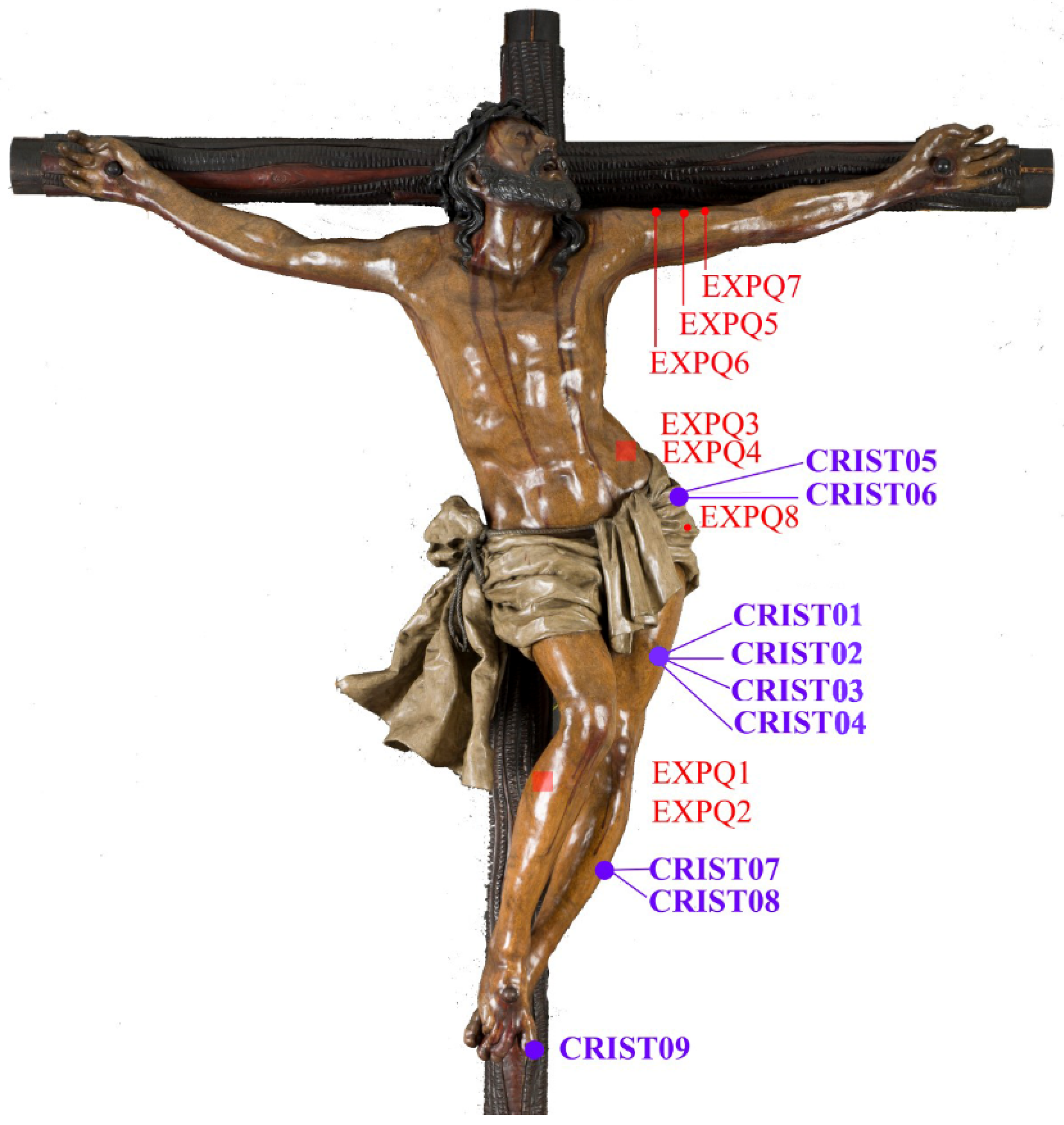
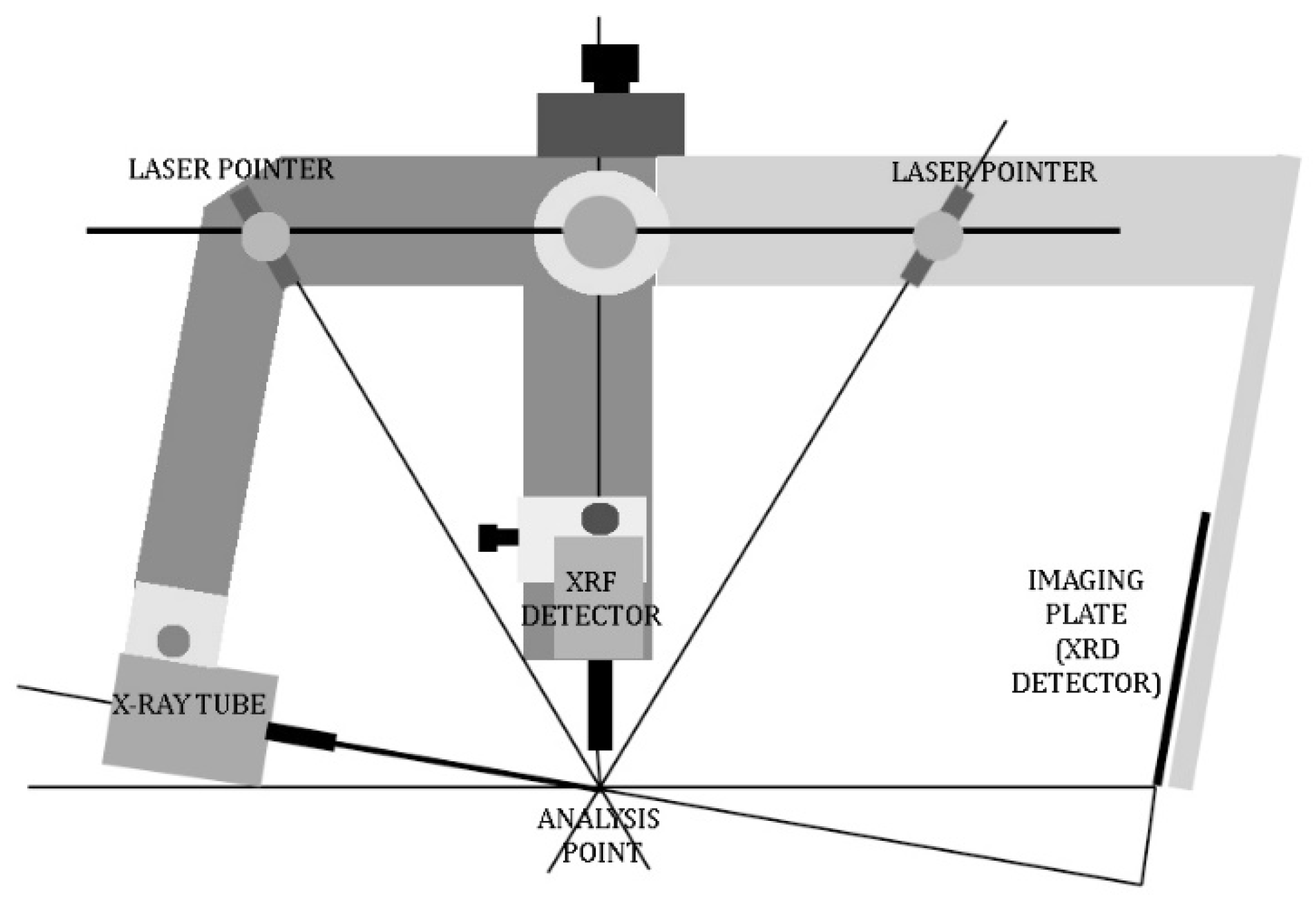
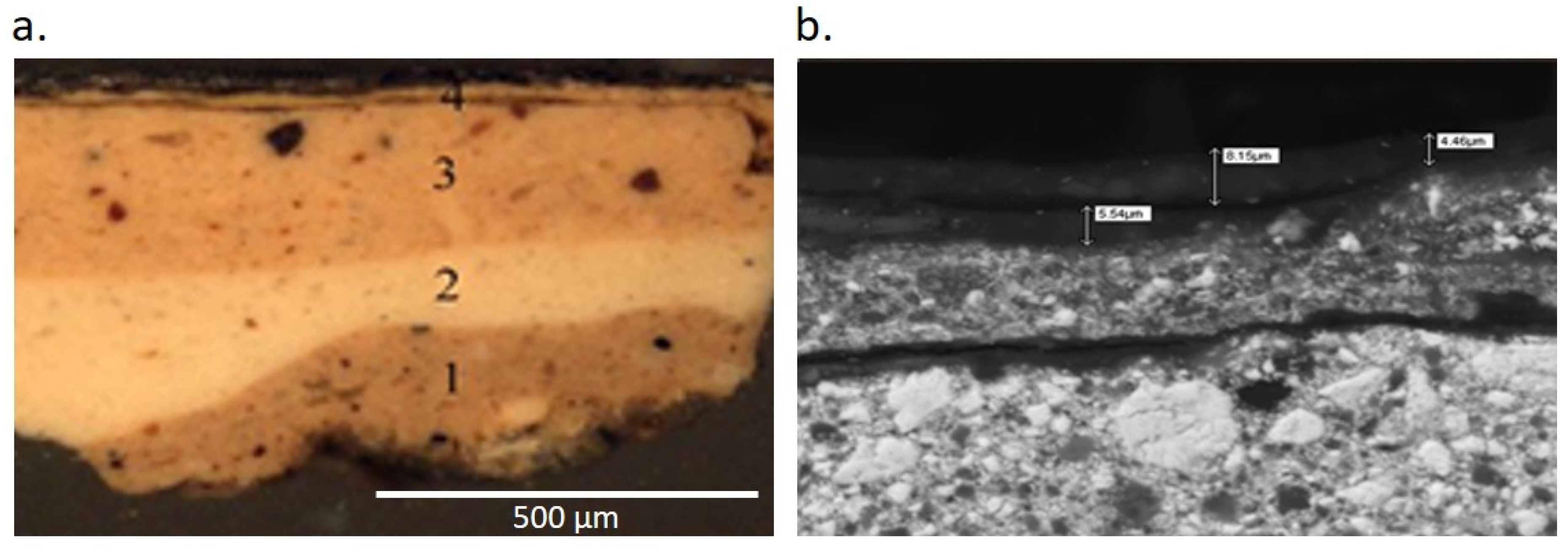
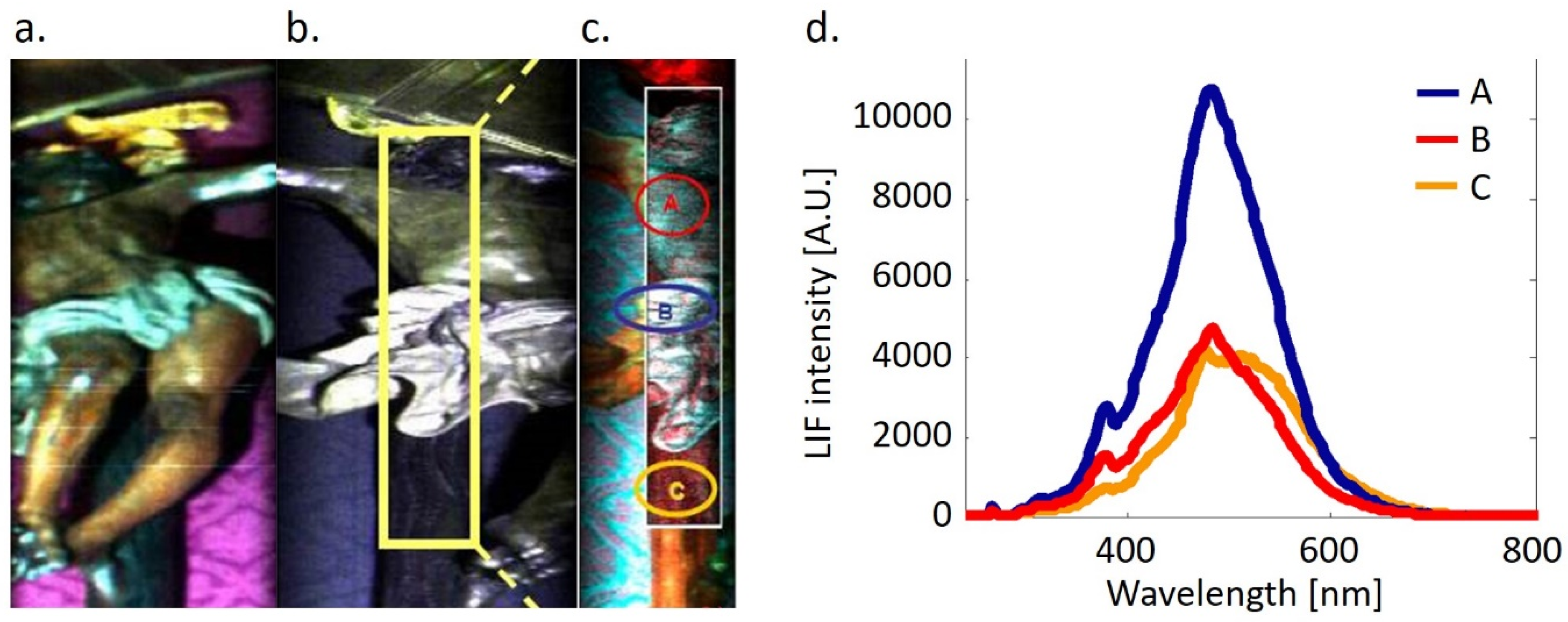
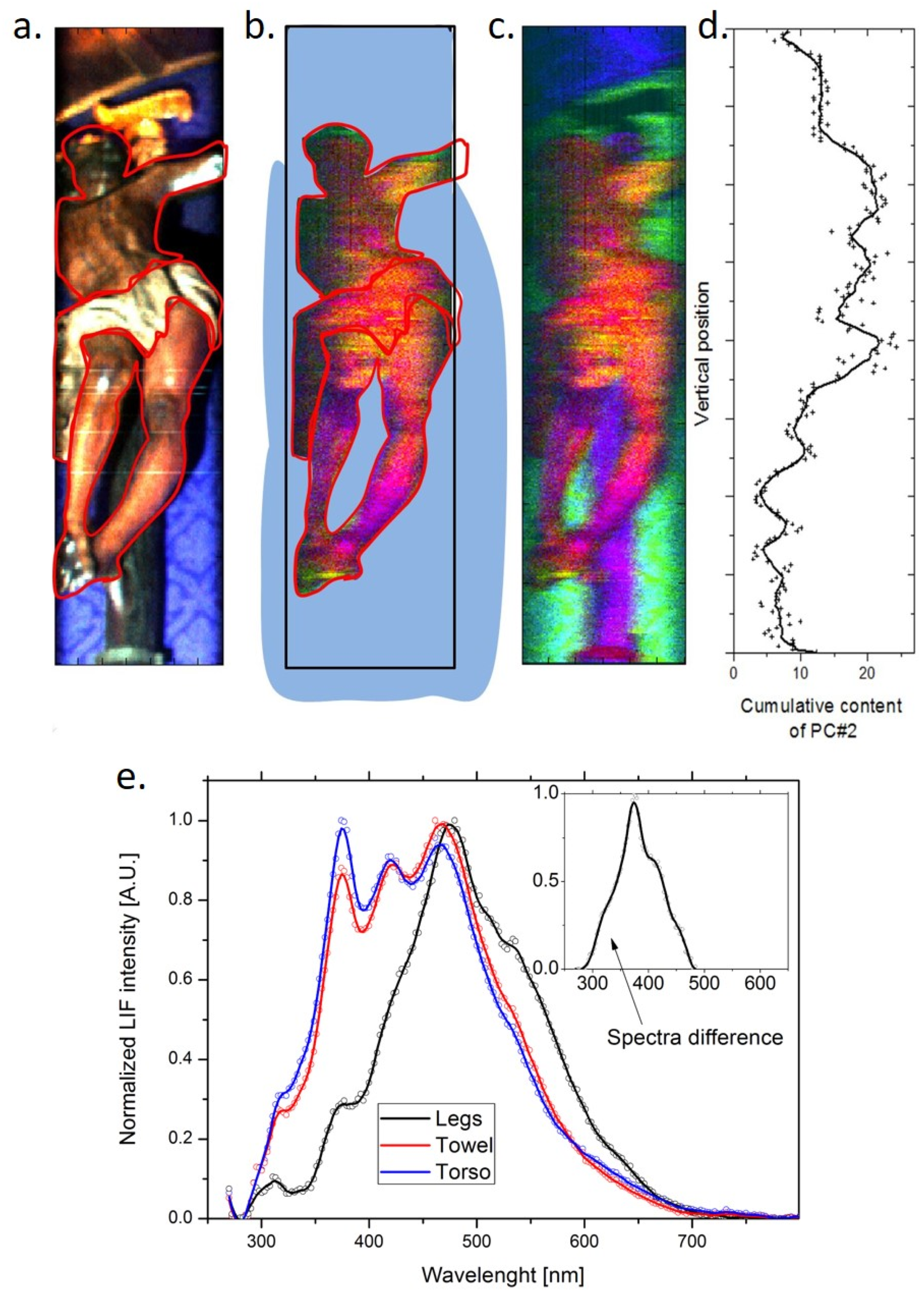
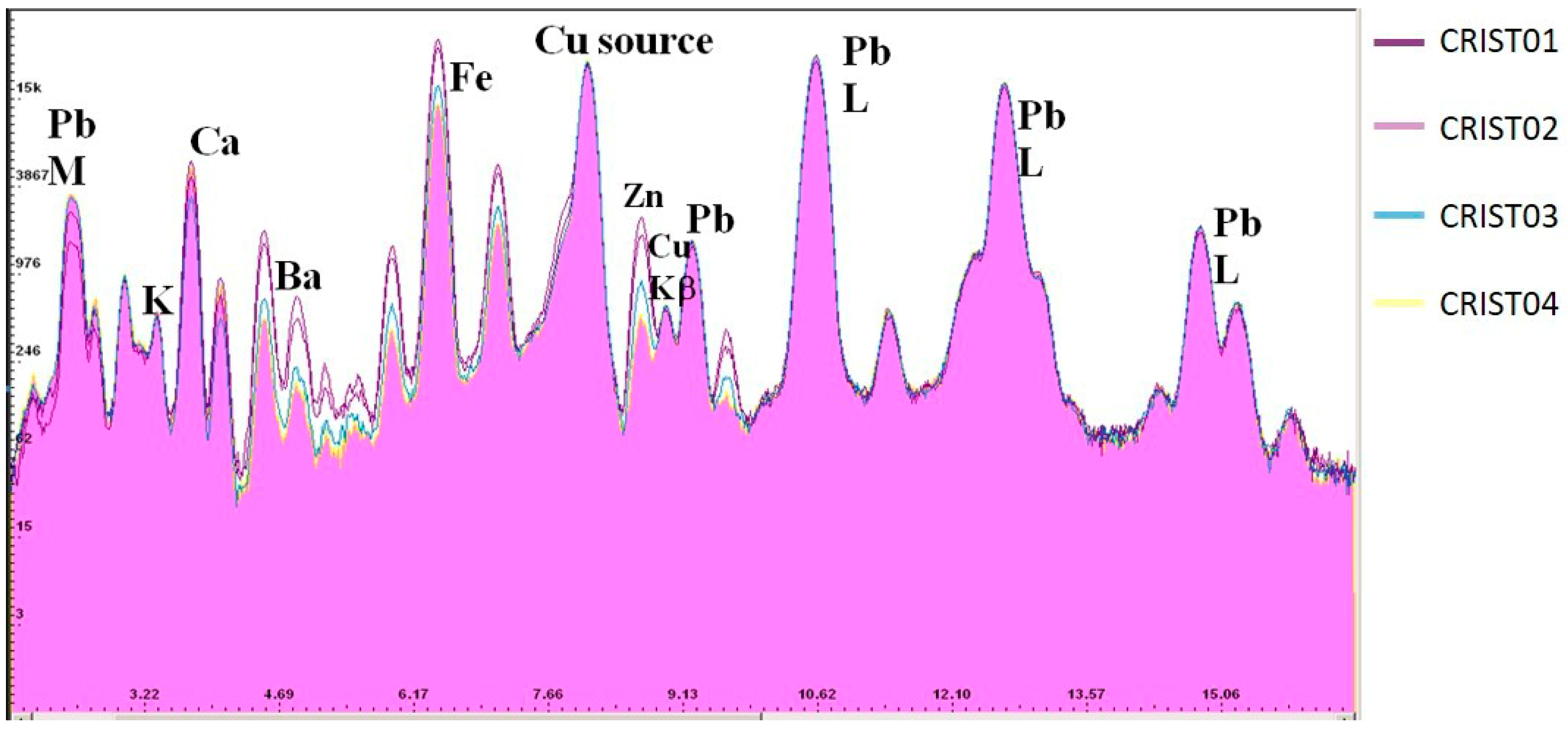

| Sample | Description | OM Stratigraphy | Thickness µm | Elements Detected by SEM-EDX * | Suggested Materials |
|---|---|---|---|---|---|
| EXPQ5 | Carnation left arm | Brown primer | 50 | Ca, S | Gypsum, animal glue |
| Pink layer | 200 | Pb, Al, Ca, K, Si | Lead white, red lake, calcite grains, quartz grains | ||
| White layer | 200–220 | Pb, Si, Ca, | Lead White, calcite grains, quartz grains | ||
| Pink layer | 30 | Pb, Si, Fe, Ca, Al, K, Mn | Lead White, earth red pigment, hematite, red lake, calcite grains, quartz grains, raw umber | ||
| Pink layer | 25 | Pb, Si, Fe, Ca, Al, K | Lead White, earth red pigment, hematite, red lake, calcite grains, quartz grains | ||
| EXPQ6 | Transparent-yellowish final layer. Varnish scraped with scalpel | Ca, Fe, Mn, Si, S, Ba, Zn, P, Al, Na, K | Hematite, earth red pigment, barite and zinc white, raw umber, bone black (known commercially as Vandyke brown) | ||
| EXPQ7 | Carnation left arm | Brown primer | 90–200 | Ca, S | Gypsum, animal glue |
| white layer | 45–125 | Pb, Ca, K, Si | Lead white, calcite grains, quartz grains | ||
| Pink layer | 200–225 | Pb, Fe, al, Si, K, Ca, | Lead White, hematite, earth red pigment, red lake, calcite grains, quartz grains | ||
| Pink layer | 30 | Pb, Si, Fe, Ca, Al, K, Mn | Lead White, earth red pigment, hematite, red lake, calcite grains, quartz grains |
| Sample | Description | Characteristic Infrared Bands cm−1 | Suggested Materials |
|---|---|---|---|
| EXPQ1 | Transparent-yellowish final layer. Varnish scraped with scalpel. | 2918, 2850, 1723, 1448, 1383, 1244, 1140, 1115, 1023, 679 | Acrylic resin |
| EXPQ2 | Second layer of varnish, Transparent-yellowish (scraped with scalpel). | 2918, 2850, 1723, 1448, 1383, 1244, 1140, 1115, 1023, 679 | Acrylic resin |
| EXPQ3 | Transparent-yellowish final layer. Varnish scraped with scalpel. | 2918, 2850, 1723, 1448, 1383, 1244, 1140, 1115, 1023, 679 | Acrylic resin |
| EXPQ4 | Second layer of varnish, Transparent-yellowish (scraped with scalpel). | 2918, 2850, 1723, 1448, 1383, 1244, 1140, 1115, 1023, 679 | Acrylic resin |
| Color | XRF-XRD | Traditional Techniques (FTIR, OM, SEM-EDX) |
|---|---|---|
| White | Barite, hidrocerussite and cerussite, calcite, zinc oxide. | white lead calcite, zinc white |
| Red | Fe in XRF (hematite) | Red lake, red earth, hematite |
| Brown | Mn in XRF manganese oxide (MnO) | Manganese oxide |
© 2020 by the authors. Licensee MDPI, Basel, Switzerland. This article is an open access article distributed under the terms and conditions of the Creative Commons Attribution (CC BY) license (http://creativecommons.org/licenses/by/4.0/).
Share and Cite
Gómez-Morón, A.; Ortiz, P.; Ortiz, R.; Colao, F.; Fantoni, R.; Castaing, J.; Becerra, J. Multi-Approach Study Applied to Restoration Monitoring of a 16th Century Wooden Paste Sculpture. Crystals 2020, 10, 708. https://doi.org/10.3390/cryst10080708
Gómez-Morón A, Ortiz P, Ortiz R, Colao F, Fantoni R, Castaing J, Becerra J. Multi-Approach Study Applied to Restoration Monitoring of a 16th Century Wooden Paste Sculpture. Crystals. 2020; 10(8):708. https://doi.org/10.3390/cryst10080708
Chicago/Turabian StyleGómez-Morón, Auxiliadora, Pilar Ortiz, Rocio Ortiz, Francesco Colao, Roberta Fantoni, Jacques Castaing, and Javier Becerra. 2020. "Multi-Approach Study Applied to Restoration Monitoring of a 16th Century Wooden Paste Sculpture" Crystals 10, no. 8: 708. https://doi.org/10.3390/cryst10080708
APA StyleGómez-Morón, A., Ortiz, P., Ortiz, R., Colao, F., Fantoni, R., Castaing, J., & Becerra, J. (2020). Multi-Approach Study Applied to Restoration Monitoring of a 16th Century Wooden Paste Sculpture. Crystals, 10(8), 708. https://doi.org/10.3390/cryst10080708






